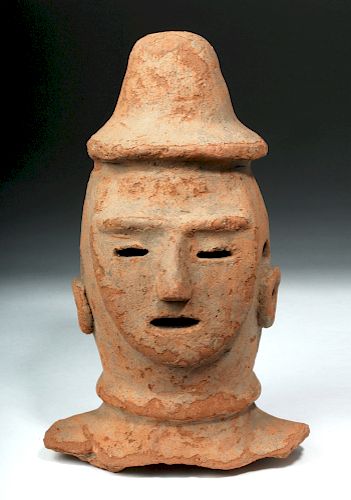Japanese Kofun Haniwa Pottery Head - TL Tested
Lot 107
About Seller
Artemis Gallery
686 S Taylor Ave, Ste 106
Louisville, CO 80027
United States
Selling antiquities, ancient and ethnographic art online since 1993, Artemis Gallery specializes in Classical Antiquities (Egyptian, Greek, Roman, Near Eastern), Asian, Pre-Columbian, African / Tribal / Oceanographic art. Our extensive inventory includes pottery, stone, metal, wood, glass and textil...Read more
Estimate:
$3,000 - $4,000
Absentee vs Live bid
Two ways to bid:
- Leave a max absentee bid and the platform will bid on your behalf up to your maximum bid during the live auction.
- Bid live during the auction and your bids will be submitted real-time to the auctioneer.
Bid Increments
| Price | Bid Increment |
|---|---|
| $0 | $25 |
| $300 | $50 |
| $1,000 | $100 |
| $2,000 | $250 |
| $5,000 | $500 |
| $10,000 | $1,000 |
| $20,000 | $2,500 |
| $50,000 | $5,000 |
| $100,000 | $10,000 |
| $200,000 | $20,000 |
About Auction
By Artemis Gallery
May 10, 2018
Set Reminder
2018-05-10 10:00:00
2018-05-10 10:00:00
America/New_York
Bidsquare
Bidsquare : Fine Ethnographic / Asian / Ancient Art
https://www.bidsquare.com/auctions/artemis-gallery/fine-ethnographic-asian-ancient-art-3213
Featuring antiquities from around the world including Pre-Columbian, Tribal, Classical, Asian, so much more! Artemis Gallery info@artemisgallery.com
Featuring antiquities from around the world including Pre-Columbian, Tribal, Classical, Asian, so much more! Artemis Gallery info@artemisgallery.com
- Lot Description
East Asia, Japan, Kofun Period, ca. 450 to 600 CE. A fantastic and rare ceramic head with mask-like human features and a conical hat. His eyes and mouth are open, narrow slits, while his nose and eyebrows are in relief. His ears are perforations on the sides of his head, with thick rings made of applied clay hanging below them. At his neck is a round ring suggesting a choker above a flaring "shoulder". He probably once had a full body. The clay used to make this figure and others like it was deliberately course and absorbent, intended to stand the test of time. The hat he wears gives us a clue as to the fashion worn by people during this time period. Size: 6.8" W x 10.5" H (17.3 cm x 26.7 cm)
This form of pottery is known as "haniwa", meaning "clay cylinder" or "circle of clay" in Japanese. These are large, hollow, earthenware funerary objects, which were placed atop large mounded tombs known as "kofun", which means "old tomb" in a circle. The tombs are such a hallmark of this prehistoric time period that researchers call it by their name. This ceramic head is the type of funerary good made to be seen - they were placed to mark the open surfaces of the huge tombs, which were denuded of trees, covered with gravel arranged in artistic designs, and surrounded by moats. Haniwa like this head were made by hand (rather than cast), and the most care in making them was given to human figures like this one and to horses, who were vitally important in this period of mounted warfare.
This piece has been tested using thermoluminescence (TL) and has been found to be ancient; if purchased, you will receive a report confirming its age.
Provenance: private Illinois, USA collection
All items legal to buy/sell under U.S. Statute covering cultural patrimony Code 2600, CHAPTER 14, and are guaranteed to be as described or your money back.
A Certificate of Authenticity will accompany all winning bids.
We ship worldwide and handle all shipping in-house for your convenience.
#126565Surface wear commensurate with age. Loss to back of hat and small losses around edges. The head is a fragment separated from a larger hollow body.Condition
- Shipping Info
-
All shipping is handled in-house for your convenience. Your invoice from Artemis Gallery will include shipping calculation instructions. If in doubt, please inquire BEFORE bidding for estimated shipping costs for individual items.
-
- Buyer's Premium



 EUR
EUR CAD
CAD AUD
AUD GBP
GBP MXN
MXN HKD
HKD CNY
CNY MYR
MYR SEK
SEK SGD
SGD CHF
CHF THB
THB

















